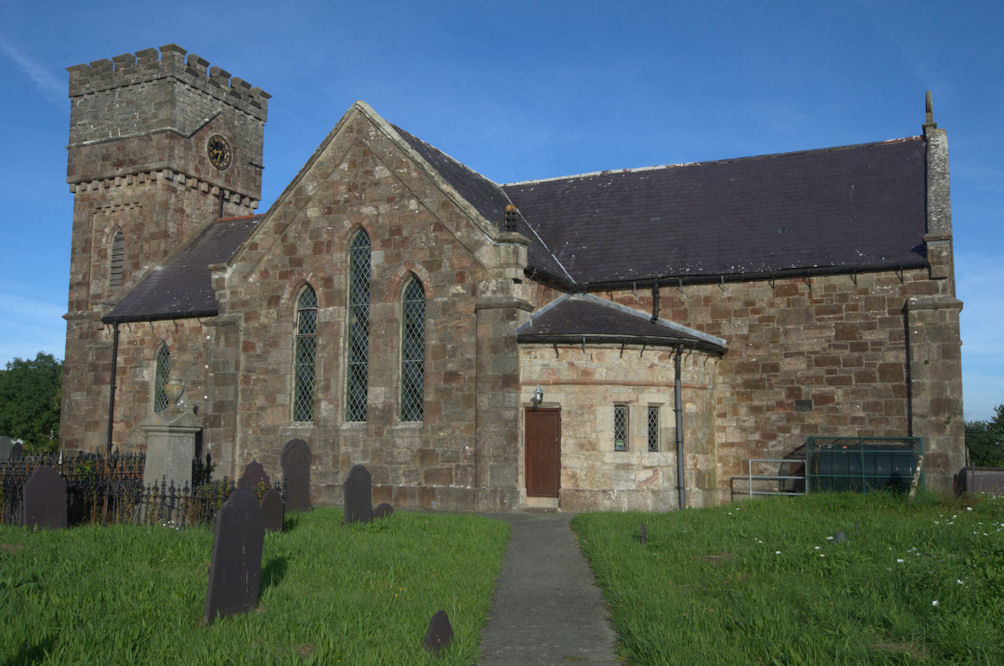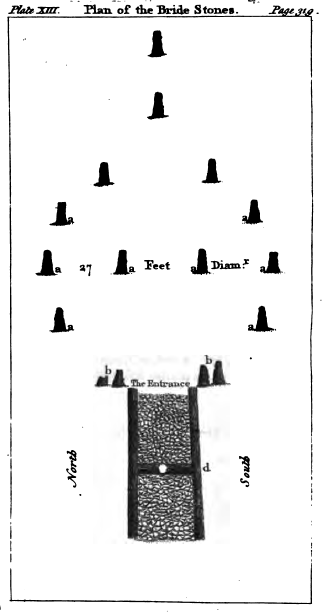|
Henry Rowlands
Henry Rowlands (1655–1723) was rector of Llanidan on Anglesey, and the author of ''Mona Antiqua Restaurata: An Archaeological Discourse on the Antiquities, Natural and Historical, of the Isle of Anglesey, the Antient Seat of the British Druids'' (first edition, 1723). The book includes an early description of The Bridestones. Life The son of William Rowlands, of Plas Gwyn, Llanedwen, Anglesey, by his wife Maud, daughter of Edward Wynne of Penhesgyn, he was born in 1655 at Plas Gwyn, the seat of the Rowlands family. He received a classical education, took holy orders, and was presented on 2 Oct. 1696 to the living of Llanidan, to which three small chapels were attached. Rowlands never travelled far from home. He died on 21 November 1723, and was buried at Llanedwen church. By his wife, Elizabeth Nicholas, he left two daughters and three sons. Works Rowlands investigated of stone circles, cromlech A cromlech (sometimes also spelled "cromleh" or "cromlêh"; cf Welsh ''crom' ... [...More Info...] [...Related Items...] OR: [Wikipedia] [Google] [Baidu] |
Old Church Of St Nidan, Llanidan
The Old Church of St Nidan, Llanidan is a medieval church in the community of Llanidan, in Anglesey, North Wales, close to the Menai Strait. The first church on the site was established in the 7th century by St Nidan, the confessor of the monastery at Penmon, Anglesey, but the oldest parts of the present structure, are now closed and partly ruined, date from the 14th century. In about 1500 the church was enlarged by the addition of a second nave on the north side, separated from the earlier nave by an arcade of six arches. During 1839 till 1843 a new church was built nearby to serve the local community, partly due to the cost of repairing the old church. Much of the building was subsequently demolished, leaving only part of the western end and the central arcade. The decision was condemned at the time by Harry Longueville Jones, a clergyman and antiquarian, who lamented the "melancholy fate" of what he called "one of the largest and most important hurchesin the island of An ... [...More Info...] [...Related Items...] OR: [Wikipedia] [Google] [Baidu] |
Anglesey
Anglesey (; cy, (Ynys) Môn ) is an island off the north-west coast of Wales. It forms a principal area known as the Isle of Anglesey, that includes Holy Island across the narrow Cymyran Strait and some islets and skerries. Anglesey island, at , is the largest in Wales, the seventh largest in Britain, largest in the Irish Sea and second most populous there after the Isle of Man. Isle of Anglesey County Council administers , with a 2011 census population of 69,751, including 13,659 on Holy Island. The Menai Strait to the mainland is spanned by the Menai Suspension Bridge, designed by Thomas Telford in 1826, and the Britannia Bridge, built in 1850 and replaced in 1980. The largest town is Holyhead on Holy Island, whose ferry service with Ireland handles over two million passengers a year. The next largest is Llangefni, the county council seat. From 1974 to 1996 Anglesey was part of Gwynedd. Most full-time residents are habitual Welsh speakers. The Welsh name Ynys M ... [...More Info...] [...Related Items...] OR: [Wikipedia] [Google] [Baidu] |
The Bridestones
The Bridestones is a chambered cairn, near Congleton, Cheshire, England, that was constructed in the Neolithic period about 3500–2400 BC. It was described in 1764 as being long and wide, containing three separate compartments, of which only one remains today. The remaining compartment is long by wide, and consists of vertical stone slabs, divided by a now-broken cross slab. The cairn originally had a stone circle surrounding it, with four portal stones; two of these portal stones still remain. The site is protected as a scheduled ancient monument. Condition in 18th century The state of the site was recorded in the second edition of Henry Rowlands's ''Mona Antiqua Restaurata'' (published in 1766), based on a report by Rev. Thomas Malbon, rector of Congleton. As the report describes removal of stones for road-building in 1764 (the Ashbourne–Leek–Congleton Turnpike, now Dial Lane, just south of the site), it appears that it was included by Henry Owen, editor of the s ... [...More Info...] [...Related Items...] OR: [Wikipedia] [Google] [Baidu] |
Plas Gwyn
Plas Gwyn is an area in the Community (Wales), community of Pentraeth, Anglesey, Ynys Môn, Wales, which is 131.8 miles (212 km) from Cardiff and 211.2 miles (339.8 km) from London. References See also *List of localities in Wales by population Villages in Anglesey Pentraeth {{Anglesey-geo-stub ... [...More Info...] [...Related Items...] OR: [Wikipedia] [Google] [Baidu] |
Llanedwen
Llanedwen is a village in the community of Llanddaniel Fab, Ynys Môn, Wales, which is 126.5 miles (203.6 km) from Cardiff and 208.8 miles (336 km) from London. St Edwen's Church, Llanedwen is located in the area. References See also * List of localities in Wales by population The following is a list of built-up areas in Wales by population according to the 2011 Census. See also *List of cities in Wales *List of towns in Wales References {{Wales topics Loc Towns A town is a human settlement. Towns are gene ... Villages in Anglesey {{Anglesey-geo-stub ... [...More Info...] [...Related Items...] OR: [Wikipedia] [Google] [Baidu] |
Stone Circle
A stone circle is a ring of standing stones. Most are found in Northwestern Europe – especially in Britain, Ireland, and Brittany – and typically date from the Late Neolithic and Early Bronze Age, with most being built from 3000 BC. The best known examples include those at the henge monument at Avebury, the Rollright Stones, and elements within the ring of standing stones at Stonehenge. Scattered examples exist from other parts of Europe. Later, during the Iron Age, stone circles were built in southern Scandinavia. Stone circles are usually grouped in terms of the shape and size of the stones, the span of their radius, and their population within the local area. Although many theories have been advanced to explain their use, usually related to providing a setting for ceremony or ritual, no consensus exists among archaeologists regarding their intended function. Their construction often involved considerable communal effort, including specialist tasks such as planning, quar ... [...More Info...] [...Related Items...] OR: [Wikipedia] [Google] [Baidu] |
Dolmen
A dolmen () or portal tomb is a type of single-chamber megalithic tomb, usually consisting of two or more upright megaliths supporting a large flat horizontal capstone or "table". Most date from the early Neolithic (40003000 BCE) and were sometimes covered with earth or smaller stones to form a tumulus (burial mound). Small pad-stones may be wedged between the cap and supporting stones to achieve a level appearance.Murphy (1997), 43 In many instances, the covering has eroded away, leaving only the stone "skeleton". The Korean Peninsula is home to the world's highest concentration of dolmens,UNESCO World Heritage List. "Gochang, Hwasun and Ganghwa Dolmen Sites." https://whc.unesco.org/en/list/977 including "cemeteries" consisting of 30–100 examples located in close proximity to each other; with over 35,000 dolmens, Korea alone (for unknown reasons) accounts for approximately 40% of the global total. History It remains unclear when, why and by whom the earliest dolmens were mad ... [...More Info...] [...Related Items...] OR: [Wikipedia] [Google] [Baidu] |
1655 Births
Events January–March * January 5 – Emperor Go-Sai ascends to the throne of Japan. * January 7 – Pope Innocent X, leader of the Roman Catholic Church and the Papal States, dies after more than 10 years of rule. * February 14 – The Mapuches launch coordinated attacks against the Spanish in Chile, beginning the Mapuche uprising of 1655. * February 16 – Dutch Grand Pensionary advisor Johan de Witt marries Wendela Bicker. * March 8 – John Casor becomes the first legally recognized slave in what will become the United States, as a court in Northampton County in the Colony of Virginia issues its decision in the Casor lawsuit, the first instance of a judicial determination in the Thirteen Colonies holding that a person who had committed no crime could be held in servitude for life. * March 25 – Saturn's largest moon, Titan, is discovered by Christiaan Huygens. April–June * April 4 – Battle of Porto Farina, Tunis: Engli ... [...More Info...] [...Related Items...] OR: [Wikipedia] [Google] [Baidu] |
1723 Deaths
Seventeen or 17 may refer to: *17 (number), the natural number following 16 and preceding 18 * one of the years 17 BC, AD 17, 1917, 2017 Literature Magazines * ''Seventeen'' (American magazine), an American magazine * ''Seventeen'' (Japanese magazine), a Japanese magazine Novels * ''Seventeen'' (Tarkington novel), a 1916 novel by Booth Tarkington *''Seventeen'' (''Sebuntiin''), a 1961 novel by Kenzaburō Ōe * ''Seventeen'' (Serafin novel), a 2004 novel by Shan Serafin Stage and screen Film * ''Seventeen'' (1916 film), an American silent comedy film *''Number Seventeen'', a 1932 film directed by Alfred Hitchcock * ''Seventeen'' (1940 film), an American comedy film *''Eric Soya's '17''' (Danish: ''Sytten''), a 1965 Danish comedy film * ''Seventeen'' (1985 film), a documentary film * ''17 Again'' (film), a 2009 film whose working title was ''17'' * ''Seventeen'' (2019 film), a Spanish drama film Television * ''Seventeen'' (TV drama), a 1994 UK dramatic short starring Christi ... [...More Info...] [...Related Items...] OR: [Wikipedia] [Google] [Baidu] |
People From Anglesey
A person (plural, : people) is a being that has certain capacities or attributes such as reason, morality, consciousness or self-consciousness, and being a part of a culturally established form of social relations such as kinship, ownership of property, or legal obligation, legal responsibility. The defining features of personhood and, consequently, what makes a person count as a person, differ widely among cultures and contexts. In addition to the question of personhood, of what makes a being count as a person to begin with, there are further questions about personal identity and self: both about what makes any particular person that particular person instead of another, and about what makes a person at one time the same person as they were or will be at another time despite any intervening changes. The plural form "people" is often used to refer to an entire nation or ethnic group (as in "a people"), and this was the original meaning of the word; it subsequently acquired its us ... [...More Info...] [...Related Items...] OR: [Wikipedia] [Google] [Baidu] |
17th-century Welsh Anglican Priests
The 17th century lasted from January 1, 1601 ( MDCI), to December 31, 1700 ( MDCC). It falls into the early modern period of Europe and in that continent (whose impact on the world was increasing) was characterized by the Baroque cultural movement, the latter part of the Spanish Golden Age, the Dutch Golden Age, the French ''Grand Siècle'' dominated by Louis XIV, the Scientific Revolution, the world's first public company and megacorporation known as the Dutch East India Company, and according to some historians, the General Crisis. From the mid-17th century, European politics were increasingly dominated by the Kingdom of France of Louis XIV, where royal power was solidified domestically in the civil war of the Fronde. The semi-feudal territorial French nobility was weakened and subjugated to the power of an absolute monarchy through the reinvention of the Palace of Versailles from a hunting lodge to a gilded prison, in which a greatly expanded royal court could be more easily k ... [...More Info...] [...Related Items...] OR: [Wikipedia] [Google] [Baidu] |


.jpg)


_1938.jpg)
